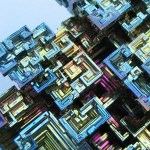crystals
Ken grows crystals. Specifically, he grows free-standing crystals made of bismuth, a metal resembling lead. It has some very interesting properties - it crystallises at right angles, and tends to form shell-like "hoppers", and natural oxidation gives the crystals a very beautiful iridescence. The end result is something that looks like a tiny futuristic city of gleaming metal skyscrapers.
The good news is, Ken sells his crystals online, and of you can't afford to buy one, you can win one by correctly guessing its weight. Ken says:
Ever drink Pepto-Bismol? Well if you have, then you've…
A crystalline botanical fashion show.
Awhile back Chemical & Engineering News published a fascinating article called "The Secret Life of Plant Crystals" with some wonderful photos of calcium oxalate crystals. Special cells (called "idioblasts") produce these crystals, with shapes that are unique to each type of plant.
Reposted for the holiday.
Even though 75% of flowering plants make these crystals, no one knows why they make them and in fact, their functions may be as diverse as their shapes. Some crystals look sharp and dangerous, like thistles or thorns, suggesting that they…
I was struck by the similarity of these two images. Which one does your dentist want you to eat?
I won't speculate about anyone's dentist's motivations, but the top image comes from The Science of Ice Cream, and the bottom from the USGS. I'm not sure what conditions the ice cream was stored under, but the USGS image is from a limestone that had been stored next to a piping hot intrusion of monzonite, and partially baked into marble.
Frozen desserts left in the freezer too long will undergo a similar process. The edges of each ice crystal are constantly exchanging water with the sugar…
It was hot out last weekend. Some of you might scoff at what I consider "hot", but the glorious thing about Seattle is that the entire city seems willing to join me in whining and wilting whenever the temperature breaks 80 (that's 25 of your Earth units). Naturally, I spent a lot of time thinking about ice cream.
Ice cream is an igneous rock. You begin with a liquid slurry containing a hodgepodge of chemicals, and by bringing it below its freezing point, you create something solid - or at least solid-ish. Good ice cream or sorbet needs a little give, a bit of liquid remaining between ice…
